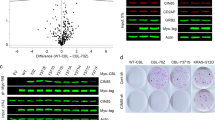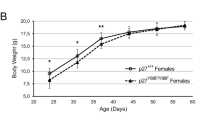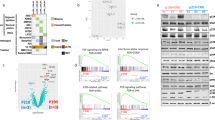Abstract
Increased tyrosine kinase activity of abl oncogene in Philadelphia chromosome positive-leukemic cells leads to activation of p21ras and phosphatidylinositol 3′-kinase (PI 3-Kinase). The mechanism of activation of these signaling pathways is not understood, but numerous studies have focused on the identification and characterization of downstream substrates of BCR/abl tyrosine kinase as potential mediators of oncogenic signaling. It was recently found that the 120 kDa protein product of the c-cbl proto-oncogene is highly tyrosine phosphorylated and associates with BCR/abl in transformed hematopoietic cells. We have characterized further cbl's involvement in BCR/abl mediated tumorigenesis using growth factor independent BCR/abl transformed BaF3 cells. Our experiments show that, in contrast to other cell types, the in vivo interaction of cbl with GRB2 and p85 is significantly enhanced in BCR/abl transformed BaF3 cells and that tyrosine phosphorylation of cbl leads to a direct interaction with GRB2, p85 and abl SH2 domains. A 14-fold increase in cbl associated PI 3-kinase activity in BCR/abl transformed cells suggests that the binding of p85 SH2 domains to tyrosine phosphorylated cbl may contribute to PI 3-kinase activation. Domain analysis studies indicate that both SH3 domains of GRB2 bind to the proline rich region of cbl in quiescent BaF3 cells, whereas GRB2 SH2 domain interacts with a non-contiguous sequence of cbl in transformed cells. Although the interaction of cbl with GRB2 in transformed cells was facilitated by binding of GRB2 to BCR/abl, phosphorylation of cbl and its interaction with p190 BCR/abl remained unaltered in BaF3 cells transformed by p190Y177F BCR/abl mutant which is unable to bind GRB2. The current information and the data presented here suggest that, although cbl lacks src homology domains, it represents a novel intermediate protein which, by interaction with key SH-containing adaptor proteins, may participate in regulation of the Ras and PI 3-kinase pathways in BCR/abl transformed hematopoietic cells.
This is a preview of subscription content, access via your institution
Access options
Subscribe to this journal
Receive 50 print issues and online access
$259.00 per year
only $5.18 per issue
Buy this article
- Purchase on Springer Link
- Instant access to full article PDF
Prices may be subject to local taxes which are calculated during checkout
Similar content being viewed by others

Author information
Authors and Affiliations
Rights and permissions
About this article
Cite this article
Jain, S., Langdon, W. & Varticovski, L. Tyrosine phosphorylation of p120cbl in BCR/abl transformed hematopoietic cells mediates enhanced association with phosphatidylinositol 3-kinase. Oncogene 14, 2217–2228 (1997). https://doi.org/10.1038/sj.onc.1201049
Received:
Revised:
Accepted:
Issue Date:
DOI: https://doi.org/10.1038/sj.onc.1201049
Keywords
This article is cited by
-
DYRK2 controls a key regulatory network in chronic myeloid leukemia stem cells
Experimental & Molecular Medicine (2020)
-
c-CBL is not required for leukemia induction by Bcr-Abl in mice
Oncogene (2003)
-
Chronic myelogenous leukemia: mechanisms underlying disease progression
Leukemia (2002)
-
Tyrosine kinase oncogenes in normal hematopoiesis and hematological disease
Oncogene (2002)
-
Cbl: many adaptations to regulate protein tyrosine kinases
Nature Reviews Molecular Cell Biology (2001)


